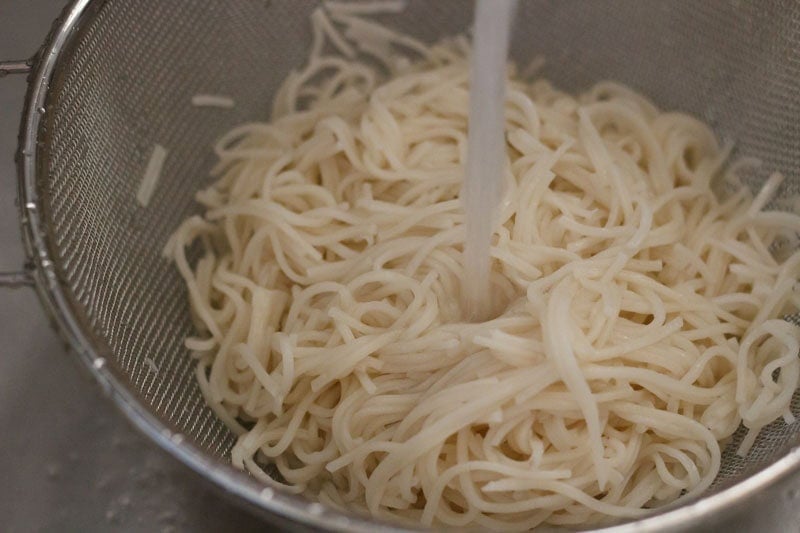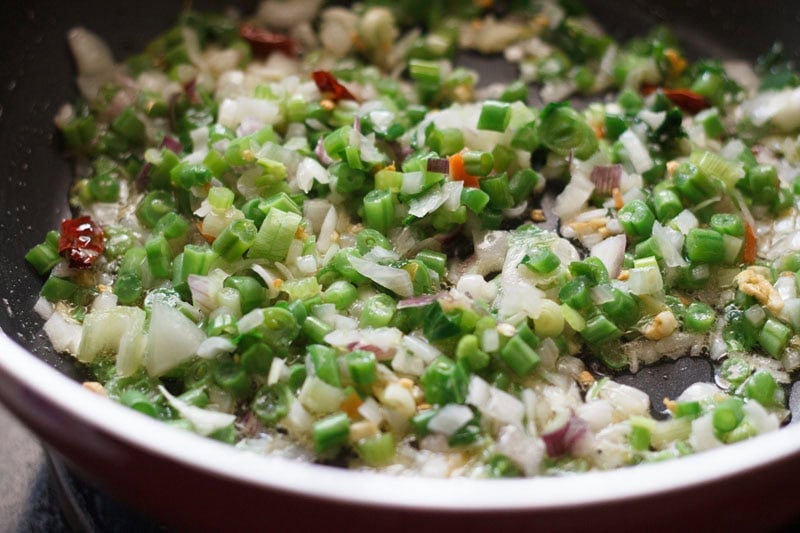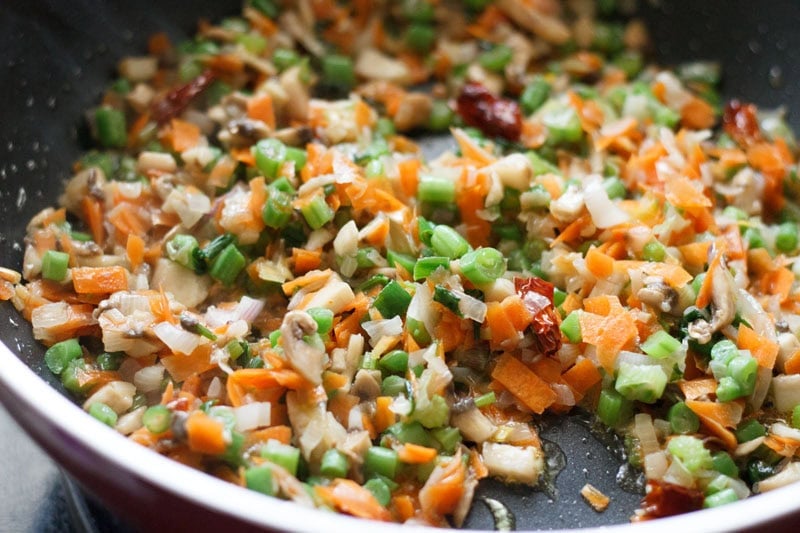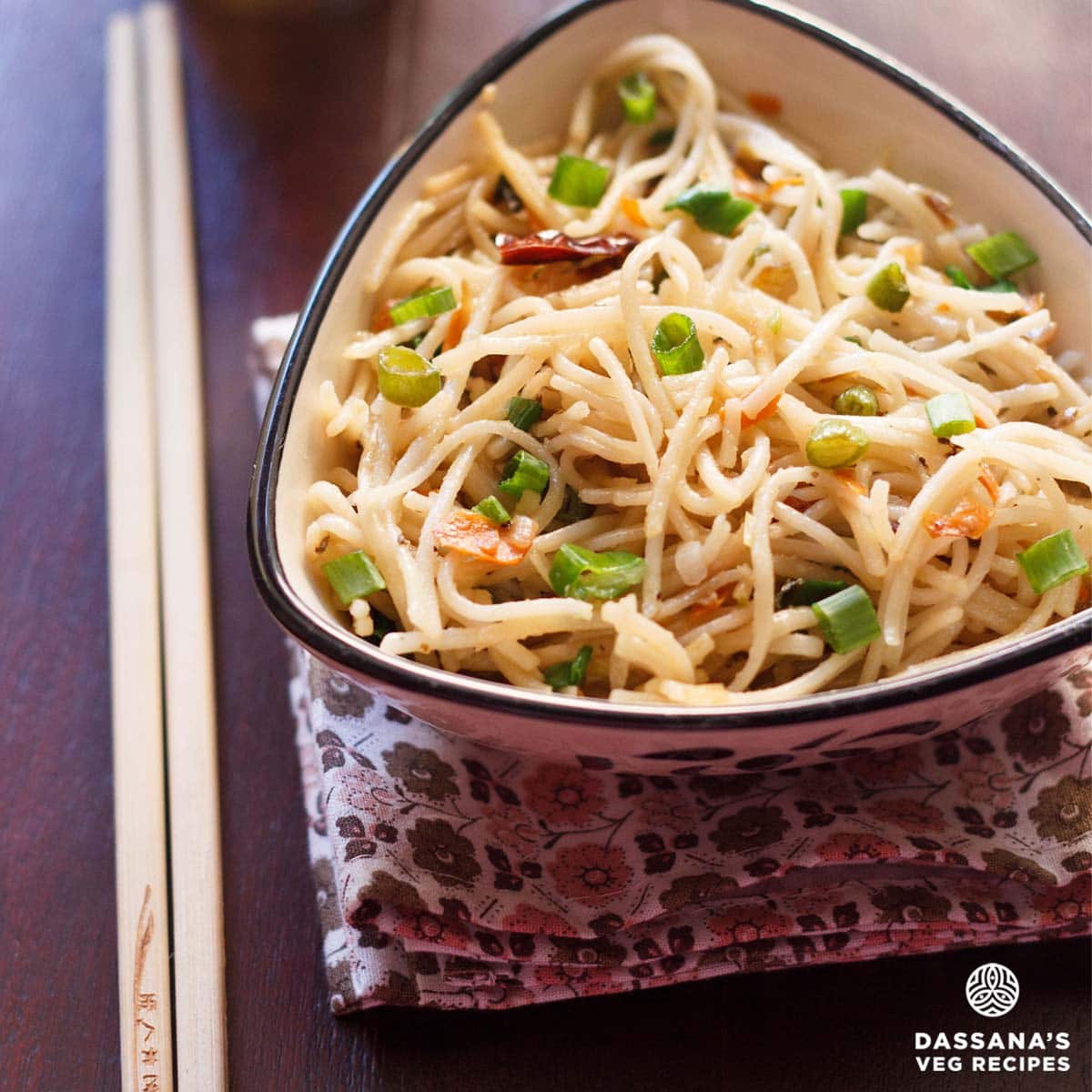The Rich History of Indo-Chinese Hakka Noodles
Hakka Noodles represent the perfect fusion of Chinese culinary traditions and Indian flavors, emerging from the vibrant streets of Kolkata in 2025. This Indo-Chinese style of cooking noodles has evolved into one of the most beloved street foods across the Indian subcontinent. The dish showcases how Chinese immigrants adapted their traditional recipes to local tastes, creating something uniquely delicious.
What Makes Hakka Noodles Special?
- Authentic blend of Chinese cooking techniques with Indian spices
- Perfect balance of vegetables and noodles
- Signature smoky wok flavor
- Versatile base for various Indo-Chinese combinations
Essential Ingredients for Perfect Hakka Noodles
The Base
- 200g Hakka Noodles (medium thickness)
- 2 tablespoons toasted sesame oil
- 2 tablespoons cooking oil (sunflower or avocado)
Fresh Vegetables
- 3-4 spring onions (whites and greens separated)
- 8-10 French beans (finely chopped)
- 1 medium carrot (julienned)
- 4-5 button mushrooms (finely sliced)
- 1 small capsicum (bell pepper)
- ½ cup cabbage (finely shredded)
Aromatics & Seasonings
- 1.5 teaspoons finely chopped garlic
- 2-3 dried red chilies
- 1.5 teaspoons soy sauce
- ¼ teaspoon rice vinegar
- Salt and black pepper to taste
- 1 teaspoon celery (optional)
Step-by-Step Hakka Noodles Recipe Guide
Part 1: Preparing the Noodles
Step 1: Boiling the Noodles
- Bring 4.5 cups water to a rolling boil
- Add ½ teaspoon salt and a few drops of oil
- Add 200g Hakka noodles
- Cook until al dente (about 3-4 minutes)

Step 2: Cooling and Preparing
- Drain noodles in a colander
- Rinse under cold running water
- Toss with 1.5 teaspoons toasted sesame oil
- Set aside while preparing vegetables

Part 2: Stir-Frying Process
Step 3: Preparing the Wok
- Heat wok or large frying pan over medium-high heat
- Add 2 tablespoons cooking oil
- Add chopped garlic and dried red chilies
- Sauté for 30 seconds until fragrant

Step 4: Adding Vegetables
- Add 3-4 spring onions (whites and greens separated)
- Add 8-10 French beans (finely chopped)
- Add 1 medium carrot (julienned)
- Add 4-5 button mushrooms (finely sliced)
- Add 1 small capsicum (bell pepper)
- Add ½ cup cabbage (finely shredded)

Step 5: Stir-Frying
- Cook vegetables until they start to soften
- Add cooled noodles and toss until well mixed
- Cook for 2-3 minutes until noodles are heated through

Step 6: Final Stir-Frying
- Add 1.5 teaspoons soy sauce
- Add ¼ teaspoon rice vinegar
- Add salt and black pepper to taste
- Cook for 1-2 minutes until sauce is well mixed


The finished dish: Restaurant-style Hakka Noodles ready to serve
Serving:
Serve your Hakka noodles piping hot! They’re fantastic on their own, but if you want to go all out, pair them with some Indo-Chinese sides like Gobi Manchurian or Chilli Paneer. A sprinkle of extra spring onions on top adds that perfect finishing touch!
Variations and Substitutions
One of the things I absolutely love about Hakka noodles is how versatile they are! Over the years, I’ve experimented with countless variations, and I’m excited to share my favorite twists on this classic recipe. Whether you’re dealing with dietary restrictions or just want to try something new, I’ve got you covered!
Vegetable Swaps
Don’t have all the vegetables listed in the main recipe? No problem! Here are some tried-and-tested substitutions:
-
Instead of French Beans:
Try sugar snap peas or snow peas – they provide that same satisfying crunch!
-
Carrot Alternatives:
Zucchini or yellow squash, cut into matchsticks, work great. They cook quickly and add beautiful color.
-
Mushroom Options:
Any mushroom variety works – shiitake adds an amazing umami boost, while oyster mushrooms provide a meaty texture.
-
Spring Onion Substitutes:
Regular onions work fine, but try to get some chives or leeks for the greens if possible.
Dietary Adaptations
-
Gluten-Free Version:
Use rice noodles or 100% buckwheat soba noodles, and replace soy sauce with tamari or coconut aminos. Just remember that rice noodles are more delicate, so handle them gently!
-
Low-Carb Option:
Try using spiralized zucchini (zoodles) or shirataki noodles. I’ve found that the key is to really drain and dry these well before stir-frying.
-
Oil-Free Cooking:
While some oil helps achieve that authentic taste, you can reduce it significantly by using a good non-stick pan and vegetable broth for moisture.
Sauce Customizations
-
Spicier Version:
Add 1-2 teaspoons of chili oil or sambal oelek. You can also increase the dried red chilies or add fresh ones.
-
Sweeter Profile:
Include 1 teaspoon of sweet soy sauce (kecap manis) or a pinch of sugar with regular soy sauce.
-
Extra Umami:
A splash of mushroom sauce or vegetarian oyster sauce takes the savory flavor to the next level.
When making substitutions, try to maintain a balance of textures and colors in your dish. This not only makes it more visually appealing but also more satisfying to eat!
Remember, these variations are just starting points – feel free to mix and match based on your preferences and what you have available. Some of my best versions came from happy accidents in the kitchen!
Troubleshooting & Frequently Asked Questions
Common Issues and Solutions
Problem: My noodles are clumping together
- Make sure you’re rinsing the noodles thoroughly with cold water after cooking
- Don’t skip the sesame oil coating step – it’s crucial for preventing clumping
- Use a larger wok or pan to give the noodles enough space
- Toss the noodles frequently while stir-frying
I once had this happen during a dinner party – quick fix was to separate them with chopsticks and add a splash of hot water while stir-frying!
Problem: Vegetables are too soft or mushy
- Make sure your wok is hot enough before adding vegetables
- Follow the vegetable sequence mentioned in the recipe – harder vegetables first
- Don’t overcrowd the pan – cook in batches if needed
- Keep the vegetables moving in the pan
Pro tip: I like to slightly undercook the vegetables as they’ll continue cooking from residual heat.
Problem: Noodles lack that restaurant-style smoky flavor
- Use a well-seasoned wok or heavy-bottom pan
- Ensure your pan is very hot before adding ingredients
- Don’t stir constantly – allow ingredients to sit for 15-20 seconds at times
- Consider using a higher smoke point oil like peanut or sunflower oil
It took me years to perfect this – the key is really in that high heat and letting the ingredients char slightly!
Frequently Asked Questions
Can I make Hakka noodles ahead of time?
Yes, but with some precautions! Cook the noodles and prep the vegetables in advance, but store them separately. The actual stir-frying should be done just before serving for the best texture and flavor. If you must reheat, use a pan rather than a microwave, and add a splash of water to prevent drying.
What’s the best type of noodles to use?
Traditional Hakka noodles are made from wheat flour and are slightly thicker than regular egg noodles. Look for “Chinese egg noodles” or “lo mein noodles” in Asian grocery stores. In a pinch, you can use regular egg noodles or even spaghetti, though the texture will be slightly different.
How long do leftover Hakka noodles last?
When stored in an airtight container in the refrigerator, leftover Hakka noodles will last 2-3 days. However, the texture is best within the first 24 hours. To reheat, stir-fry in a pan with a little oil until heated through, adding a splash of soy sauce if needed to refresh the flavors.
Why are my noodles too dark/salty?
This usually happens when too much soy sauce is added. Start with less – you can always add more! Remember that different brands of soy sauce vary in saltiness. I recommend starting with 1 tablespoon and adjusting to taste. Also, use light soy sauce rather than dark soy sauce for better color control.
Can I freeze Hakka noodles?
While you can freeze Hakka noodles, I don’t recommend it as the texture can become mushy when thawed. If you must freeze, slightly undercook the noodles and vegetables, let them cool completely, and store in an airtight container for up to 1 month. Thaw overnight in the refrigerator and reheat in a wok with fresh oil.
The key to perfect Hakka noodles is practice and patience. Don’t get discouraged if your first attempt isn’t restaurant-perfect – each time you make them, you’ll get better at judging the heat, timing, and seasoning!
Nutrition Information & Storage Tips
Nutritional Information
Per serving (1 cup, approximately 240g)
| Nutrient | Amount | % Daily Value* |
|---|---|---|
| Calories | 320 | – |
| Total Fat | 8g | 10% |
| Saturated Fat | 1.5g | 8% |
| Cholesterol | 0mg | 0% |
| Sodium | 680mg | 30% |
| Total Carbohydrates | 54g | 20% |
| Dietary Fiber | 4g | 14% |
| Total Sugars | 3g | – |
| Protein | 10g | 20% |
| Vitamin D | 0mcg | 0% |
| Calcium | 30mg | 2% |
| Iron | 2.5mg | 14% |
| Potassium | 320mg | 7% |
* Percent Daily Values are based on a 2,000 calorie diet. Your daily values may be higher or lower depending on your calorie needs.
Additional Nutritional Notes:
- This recipe is naturally vegan when made as directed
- Good source of fiber from vegetables and whole wheat noodles
- Contains heart-healthy unsaturated fats from sesame oil
- Rich in antioxidants from colorful vegetables
- Provides complex carbohydrates for sustained energy
Storage and Meal Prep Guide
Short-term Storage (2-3 days)
-
Refrigeration:
Store in an airtight container in the refrigerator. For best results, slightly undercook the noodles if you plan to reheat them later.
-
Reheating:
Heat in a wok or large pan over medium-high heat. Add a splash of water or oil to prevent drying. Avoid microwave reheating as it can make the noodles mushy.
Meal Prep Tips
-
Component Preparation:
Chop vegetables and store them separately in airtight containers up to 2 days in advance.
-
Sauce Preparation:
Mix sauces ahead of time and store in a small jar in the refrigerator for up to a week.
-
Noodle Preparation:
Cook noodles just before serving for best results. If needed, you can cook them up to 4 hours in advance, toss with sesame oil, and store in the refrigerator.
Maintaining Quality
- Keep vegetables and noodles separate until ready to serve if meal prepping
- Store in glass containers rather than plastic to prevent absorption of odors
- If the noodles seem dry after refrigeration, sprinkle with a little water before reheating
- Add fresh garnishes (spring onions, sesame seeds) just before serving
While this dish is best enjoyed fresh, proper storage techniques can help maintain its quality for several days. Remember that the texture might change slightly upon storage, but the flavors will continue to develop!




